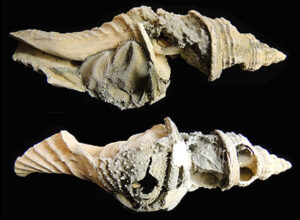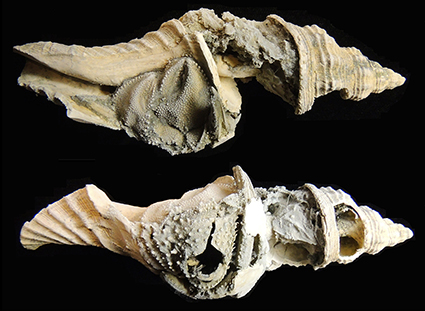
Here is the type specimen of Pagurus hazenorum. In the upper image, the two enlarged claws of the hermit crab are seen creating an armored door blocking the opening of the shell, whereby protecting the rest of the animal within
Calvert Cliffs is a great place to collect fossil shark teeth, whale and dolphin bones, and shells. Many scientifically important fossils have come from these world-famous cliffs.
The shells commonly found on the beaches belonged to gastropods (snails) and bivalves (clams) that once inhabited this area. When snails (both modern and fossil) die, their shell may become home for other creatures.
In this case, prehistoric and now-extinct hermit crabs decided to make whelk snail shells their home. Two different species of snails preserve the remains of two new species of hermit crab. These kinds of finds are exceedingly rare along Calvert Cliffs…only five comparable specimens have ever been found.
The international team of paleontologists that named these new hermit crab species included Calvert Marine Museum (CMM) Paleontology Collections Manager, John Nance, and CMM Paleontology Summer Intern, Adam Lindholm. John and Adam worked with colleagues from the Netherlands, Jonathan J.W. Wallaard, René H.B. Fraaije, Barry W.M. Van Bakel, and John W.M. Jagt to describe these amazing new finds.
The species Pagurus hazenorum (Figure 1) honors Robert and Margee Hazen, longtime friends of the CMM and avid fossil collectors. The species Paguristes timoni, is named after Timon of Athens, a hermit and misanthrope, a tragic character in ‘Timon of Athens’ a play by William Shakespeare.
Link to paper: https://www.mapress.com/zt/article/view/zootaxa.5227.3.7

Here is the type specimen of Pagurus hazenorum. In the upper image, the two enlarged claws of the hermit crab are seen creating an armored door blocking the opening of the shell, whereby protecting the rest of the animal within


